Types and varieties of hawthorn

Gardeners can use a wide variety of types and varieties of hawthorn. Such types as pinnate and Arnold are in high demand. But you also have to pay attention to the Mordena Toba and softish, to the Rooster's spur and other variants of this plant.
Common hawthorn and its varieties
This species is a tall tree with thorns. But sometimes it is also represented by a shrub form. A characteristic feature of such a hawthorn is a rounded, compacted crown. Decorative qualities are preserved until the end of the growing season. Common hawthorn in the Northern Hemisphere can live up to 250-300 years. Typical for him are dark green or yellow-green foliage, which in the fall takes on expressive red shades.


Rare thorns develop on the branches of this plant. These are the changed shoots. They are soft at first, but on mature plants they are almost as hard as good nails. The common hawthorn has become the source of many ornamental garden varieties.
Variety Lyudmila gives large fruits and is devoid of thorns. It is characterized by increased resistance to harmful microorganisms. Large-sized specimens of Lyudmila take root well in new places. The plant gives weighty fruits. It will bloom in May and June. Excellent root development and ability to withstand extreme cold are noted.


Zlat and Shamil - these are two more popular varieties of common hawthorn. Shamil is different:
-
resistance to cold and drought;
-
few short (30-40 mm) thorns;
-
broad foliage;
-
spherical 20 mm fruits;
-
juicy sweet and sour pulp;
-
brown, gradually gray shoots.
The hawthorn Zlat initially develops dark brown shoots. It is a late variety with large, decent-tasting fruits. Sweet and sour berries ripen by the end of September.
This plant has no thorns. However, it can freeze under severe winter conditions.


Features of Arnold hawthorn
This is the name of a tree with a height of 6 to 8 m. It is crowned with a dense asymmetrical crown in the form of a wide circle. The section of this crown reaches 6 m. The relatively thin brown shoots of Arnold's hawthorn are covered with large thorns. The foliage is shaped like a wide egg or an oval; trees will bear berries from the age of 6.
Arnold's hawthorn blooms to form relatively large flowers. Their smell is difficult to confuse with anything else. Flat shields of a complex structure are loose. Flowering usually occurs at the end of May and the first half of June. Characterized by the appearance of large bright red berries, which tend to fall off suddenly.



Other popular varieties
Douglas
In nature, this species develops on the banks of mountain rivers and streams. It is also found in woodlands, rising to an altitude of 1600 m above sea level. It is a deciduous monoecious tree, growing up to 9-12 m, but sometimes bushy (in the form of clumps) development is noted.
Neutral, slightly acidic, and slightly alkaline soil is suitable for its growth. The main thing is that it should be loam.
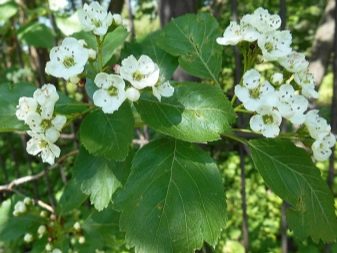
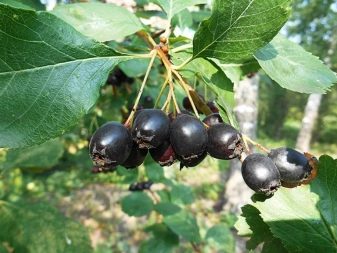
Holmes
Until now, there has been no horticultural description of this culture in Russian. It has been established that such a plant can survive cooling down to –25 degrees. It thrives on chalk ground and heavy, dense clay. The branches grow upward, the total height of Holmes hawthorn can reach 4-9 m, in some cases up to 10 m. The edibility of the fruit is noted.

Elvanger
Such a hawthorn is a typical tree up to 6 m high. In natural conditions, it is mainly found in the Great Lakes region. The section of the trunk can reach 0.3 m. The egg-shaped leaves are 60-90 mm long and 50-75 mm wide. They also note:
-
dense furry inflorescences;
-
May bloom;
-
September fruiting;
-
ellipsoidal bright red fruits.

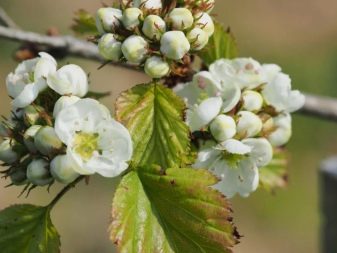
Softish
This is a typical representative of the North American flora. It is both aesthetic and unpretentious. In culture, the softish hawthorn has been cultivated since 1830. In our country, such a plant is actively used throughout the European part. Its dense crown is predominantly in the shape of a ball.
The foliage is in the shape of an egg or an oval. All leaves have a pointed tip. Leaf fall occurs relatively late. Inflorescences include 12 to 15 flowers. The abundance of essential oil in the flowers contributes to the spread of an expressive scent over a long distance.
Other features:
-
the length of pear-shaped fruits is up to 20 mm;
-
noticeable pubescence of berries;
-
somewhat dryish pulp;
-
sugar content - up to 15%.

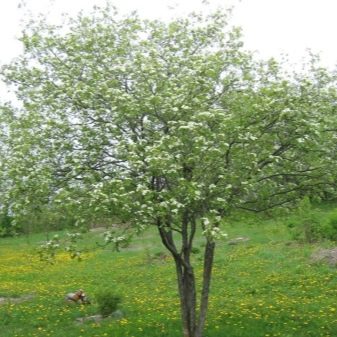
Rooster spur
It is also a tree, and one of the best types of hawthorn. The original form is found in eastern North America. Rooster spur is mostly deciduous, occasionally semi-evergreen culture. Its height generally reaches 6-8 m. Sometimes it can be up to 12 m, but bushy specimens are also possible.
A characteristic feature of the plant is a gray-brown color. Red-brown shoots shine. There are quite a lot of thorns, and they are spaced perpendicularly; their ends are bent downwards. The length of the petioles reaches 5-20 mm. Bare inflorescences consist of 15-20 flowers, the section of which is 15-20 mm; the petals are white.
The cock's spur blooms in early April. Fruits are ready for harvest by the end of October. The crop can overwinter on the branches. Such a plant develops well throughout Russia, which is appreciated by many landscape designers.
In difficult climatic conditions (St. Petersburg, Far East), freezing is likely.


Blood red
It is quite winter-hardy plant, whose height reaches 5 m. Resistance to drought and shading is noted. Pay attention to the fact that this type of hawthorn can develop on all types of soil. Excessive hydration is contraindicated. Both in spring and autumn, this tree looks very beautiful.
Sometimes the blood red hawthorn is a tall shrub. He settled:
-
all of Siberia (including the Trans-Baikal Territory);
-
Kazakhstan;
-
part of the PRC;
-
Mongolia.

The root system is quite powerful, it can reach a depth of 1 m. The flowering period lasts approximately 3 weeks. Root shoots do not develop. You can count on the development of 2-centimeter fruits in September; they have a typical sweet-sour pleasant taste. Stratified seeds are used for propagation, but you can also graft or cut the plant.
This type of hawthorn is great for hedges. Its thorns will become an impenetrable barrier. You can cut the culture completely calmly. Barberry will be a good companion for him. It is worth considering combinations with other decorative and flowering cultures.
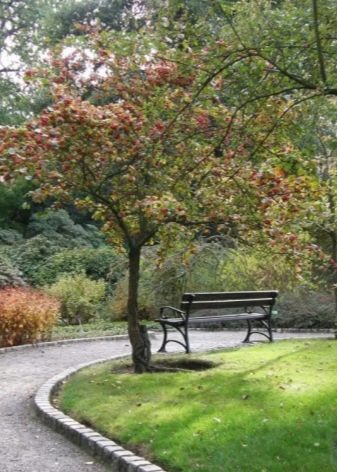

Champlain
Information about this type is extremely scarce. This hawthorn produces large fruits. They contain a noticeable amount of ascorbic acid. The concentration of carotene is also quite high. The berries have a pleasant taste.

Pinned
This, like many other hawthorns, is also a tree. In some cases, bushy growth is noted. The height of the plant can reach 2-6 m. The section of the crown is 2-4 m. The crown is close in shape to a wide pyramid and is practically symmetrical.
Other features:
-
brown-gray bark;
-
spines 10-20 mm long;
-
moderately active growth;
-
growth up to 30 cm per year in height and up to 20 cm in width;
-
life span over 50 years;
-
flowering occurs in May and June;
-
yellow autumn color;
-
white one and a half centimeter flowers, grouping in 5-centimeter inflorescences;
-
the length of edible fruits is up to 1 cm.

The pinnacled hawthorn is used in a solo landing. It is also planted on slopes and in alleys. Although the plant is light-requiring, it can also develop in partial shade. It is noted for its high frost resistance and good resistance to haircuts; replanting a culture is not difficult. The plant is found on river banks, on stony slopes of valleys; it has been used in a wide variety of plantings since 1860.


Mordensky
Such a hawthorn is also called Toba. Its height ranges from 3 to 5 m. Significant crown density is noted, which is distinguished by a rounded-spreading structure. With age, it becomes more and more flattened. Toba has a dark gray bark and is almost devoid of thorns. It is characterized by leaves with wide lobes, visually resembling an egg.
These leaves reach 40-50 mm in length. They have a characteristic shine and are darker at the top than at the bottom. In the autumn months, the foliage of the Morden hawthorn acquires a yellow-red or red-orange color. Terry flowers are characteristic, which at first are pure white, but then gradually gain a rich pink tone. You can expect flowering in late May or early June.
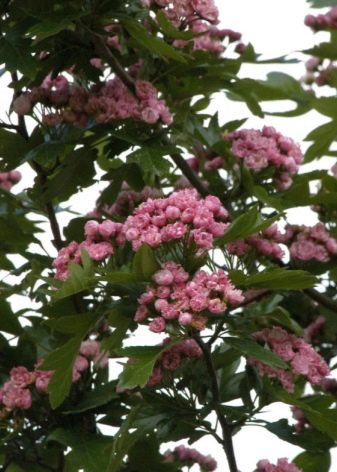

The red berries of such a hawthorn will be scarce even at the latitude of Moscow. They are not formed every year. The ripeness of the crop is reached by the end of September. This species is good both in single and in group planting. It can become a tapeworm in a shallow garden, accentuate the entrance to a garden, or be used for landscaping courtyards in cities.
Demanding soil is not great. It is better to use loose, thoroughly moistened soil with a weak alkaline reaction. Its excessive compaction is contraindicated. The soil salinity resistance is low. Resistance to urban conditions, including gas pollution, is very high.

Altaic
It is as good as varietal varieties for hedges. For this hawthorn, a group or single growth on rocky surfaces is typical. He populates Central and Central Asia. Basically, the height does not exceed 6 m. Occasionally it reaches 8 m.
Altai hawthorn has bare red-brown shoots. Whitish lentils develop on them. Sometimes there are short (up to 20 mm) spines. White flowers are grouped in complex corymbose or umbellate inflorescences. The foliage has a petiole structure and is distinguished by a green color, which is slightly diluted with a bluish bloom.

The fruits are orange-brown or pure yellow in color, similar in shape to a ball. The diameter of the berry is up to 1 cm. Each of them has 5 seeds. The seed method of reproduction is the main one, despite the laboriousness. We have to take into account the unevenness of seedlings over time.
Unstratified seeds of the Altai hawthorn will sprout only a long time after sowing. Sometimes you have to wait up to 3 years.
The choice of loose, moist ridges is recommended, the structure of which is improved with chalk. Of the maintenance measures, weeding and loosening are the most significant. This species is appreciated not only as an ornamental culture, but also as a medicinal raw material.


Fan-shaped
A similar hawthorn in nature gravitates towards river valleys. It has medium drought tolerance. It is optimal to grow it in the sun or in partial shade. The life-form is a 6-meter tree.
The fan-shaped hawthorn usually has many trunks and ascending branches. He needs a neutral, slightly acidic or slightly alkaline earth. You can plant such a crop both in spring and autumn. Seeds germinate within 1-2 years, but the germination rate is only 11%. Cuttings rooted weakly during vegetative propagation.
Watering the fan-shaped hawthorn is necessary only against the background of a prolonged drought. It retains its decorative properties throughout the growing season. The bare shoots are light gray in color. The foliage is arranged in a spiral type, the leaves visually resemble rhombuses or expanded eggs. They have a sharp top, and the petioles reach 1-4 cm in length.


For the Moscow region, the already mentioned ordinary hawthorn is well suited. An alternative to him is the green-meat (aka black-fruited) type. This plant is characterized by the presence of thorns. In nature, it is found in Kamchatka and Sakhalin. Connoisseurs note pleasant taste sensations. Near Moscow, you can also grow one-footed hawthorn.
It is capable of developing on a wide range of substrates. This is a great honey plant. This species is able to grow even up to 12 m. It has few thorns, no more than 1 cm long. Some specimens live 200 and even 300 years. Erect inflorescences have a cross section of up to 5 cm.
Among the best varieties is the large-fruited hawthorn. The size of his thorns is 4-12 cm. The flowers are painted in white, pink or red. They are grouped into thyroid inflorescences. There are oval, spherical or oblong fruits.





































































The comment was sent successfully.